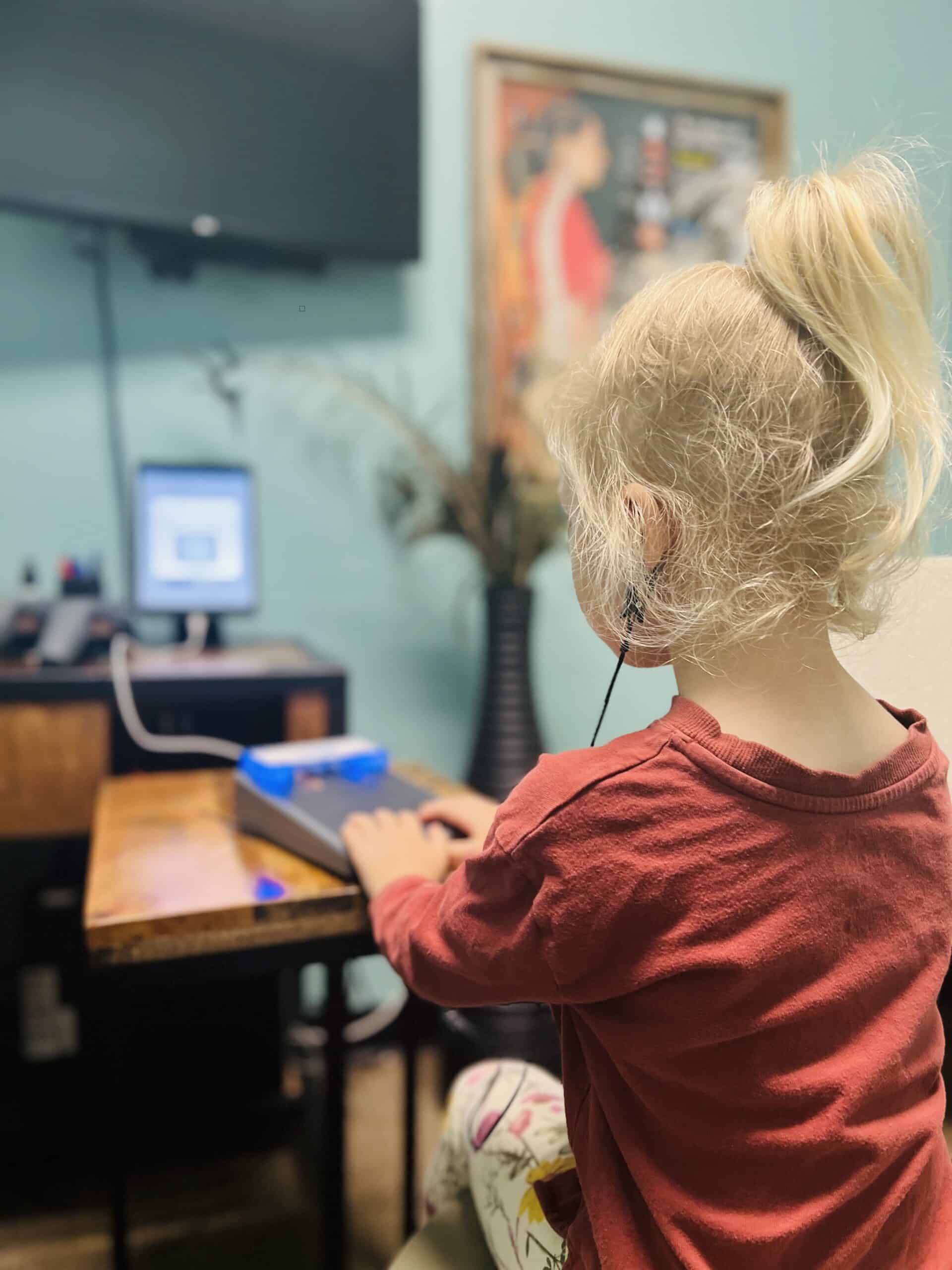Why the Nervous System Matters More Than You Think
Traditional medicine focuses on symptoms and runs tests like blood work, MRIs, or EEGs to find obvious problems. But what if your child’s issue isn’t showing up on those? That’s where Neurologically focused Chiropractic Care and INSiGHT Scans come in.
What Are INSiGHT Scans?
These scans are a safe, easy way to check how well your child’s Central Nervous System (CNS) is working. They show us how the body is functioning—not just if something looks “wrong.”
Why the Nervous System Is So Important
The CNS (aka the nervous system) is the control center of the entire body. It helps your child eat, sleep, poop, move, think, and grow. If the nervous system isn’t working right, nothing else will.
As Dr. Bruce Lipton says:
“The function of the nervous system is to perceive the environment and coordinate the function of all other cells.”
So while you may have focused on gut health, immunity, or motor development with things like PT, OT, or speech therapy… none of those will work well if the nervous system is out of sync.
What Does “Autonomic” Mean?
It means automatic. Things like breathing, digestion, sleep, and movement happen without thinking. The autonomic nervous system controls all of this—and our scans show how well it’s doing.
How Does This Compare to Other Approaches?
Here’s the breakdown:
- Traditional Medicine: Looks for disease and treats symptoms.
- PT/OT/Speech: Focus on movement and muscle tone.
- Pediatric Chiropractic: Focuses on how well the nervous system is working.
How Does the Nervous System Work?
Think of it as a two-way street:
- Sensory nerves tell the brain what’s happening inside and outside the body.
- Motor nerves tell the body what to do.
Because the nervous system controls 37.2 million cells, communication needs to be fast and clear—think beyond 5G speeds. If signals slow down or get scrambled, your child’s health suffers.
Why It Matters Most in Early Childhood
The brain doubles in size in the first year and grows rapidly until age 7. That makes early nervous system checks more important than height, weight, or other routine measurements.
INSiGHT Scans = Insight Into Your Child’s True Health
So instead of just tracking symptoms, INSiGHT Scans show how your child’s brain and body are really working—and give you a clearer path to true health.
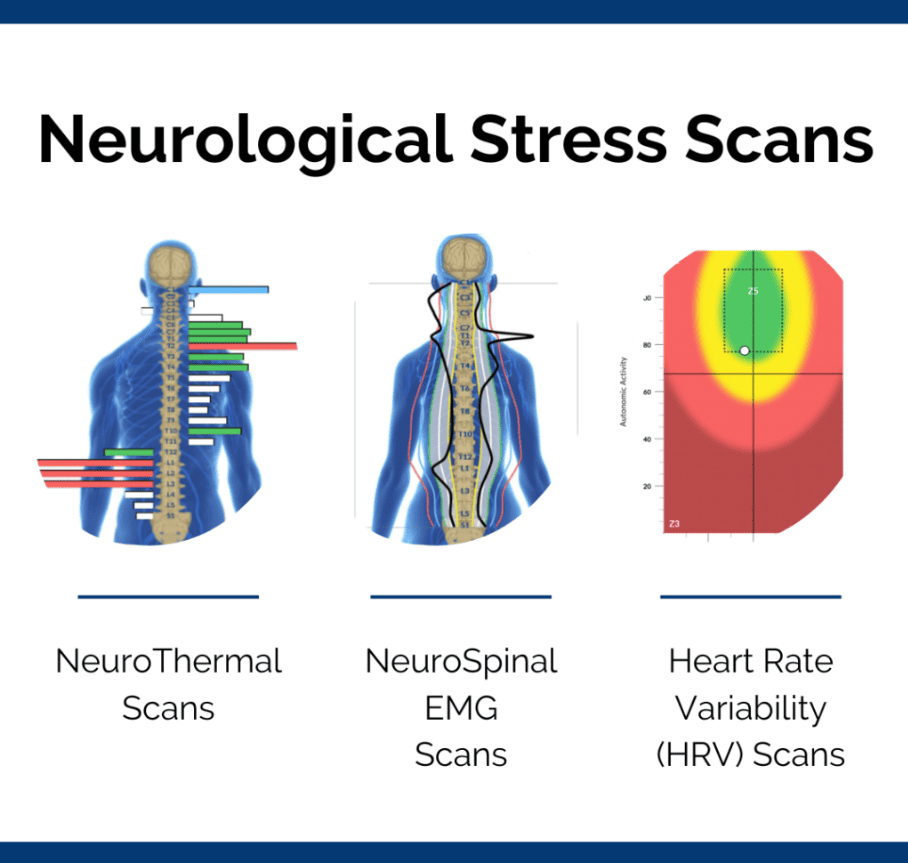
What Are INSiGHT Scans and Why Are They Important?
INSiGHT Scans help us find, track, and understand if subluxation and dysautonomia are affecting your child’s nervous system. If they are, we focus on two main things:
- How severe is the issue? (mild, moderate, severe, or intensive)
- Where is it located in the neurospinal system?
Too much stress in one area of the neurospinal system helps explain many symptoms and conditions. Think of it like a fuse box—if one circuit is overloaded, problems show up in specific areas. The same goes for your child’s nervous system.
What Are Subluxation and Dysautonomia?
These two issues cause three major problems in the nervous system:
- Built-up stress and tension
- Poor balance and coordination
- Disorganization and dysfunction
Signs your child’s nervous system may be stressed include:
- Colic and frequent crying (infants)
- Tantrums and meltdowns (toddlers)
- Motor or speech delays
- Sensory or emotional challenges
- ADHD and anxiety in older kids
What’s fascinating is we see the same stress patterns in infants, kids, and teens—just with different symptoms. The common cause? A stressed, unbalanced nervous system.
Unfortunately, many pediatricians still dismiss these early warning signs as “normal” or something kids will outgrow. But these symptoms often signal what we call The Perfect Storm—a nervous system under serious strain.
Next Up: The INSiGHT Scans
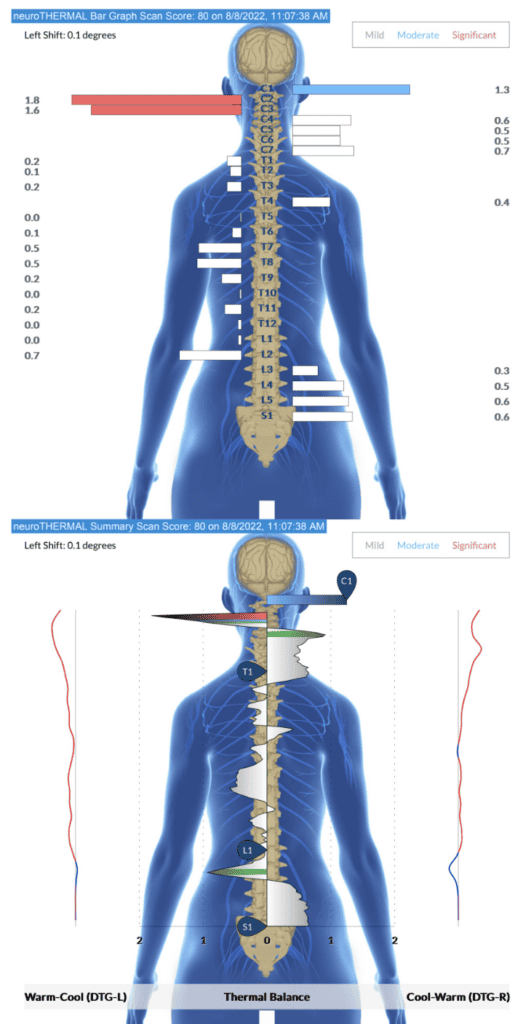
Let’s take a closer look at each scan, starting with the NeuroThermal Scan—a quick and easy scan for everyone from newborns to parents.
NeuroThermal Scan: What It Shows
The NeuroThermal Scan helps us detect how subluxation and dysautonomia are affecting specific areas of the nervous system—like reading a fuse box for the body.
Since the autonomic nervous system controls digestion, immunity, hormones, and more, this scan is especially useful for kids dealing with:
- Colic
- Reflux/ Constipation
- Chronic ear infections
- Allergies
- Sleep issues
- Adrenal and hormone imbalance
- Anxiety
The scan gives us a clear picture of how stress in the nervous system may be contributing to these challenges.
What to Look for in the NeuroThermal Scan
Dr Tim will walk you through the details, but here are 3 red flags we look for:
- Colored bars (green, blue, red) on the top graph – shows built-up tension and stress in the nervous system.
- Zig-zag or “tug of war” patterns on the bottom graph – a sign of dysautonomia and imbalance throughout the neurospinal system.
- Blue bars inside black lines on the side graphs – shows the issue is becoming chronic.
NeuroSpinal EMG Scan: A Deeper Look at Neurological Tone
This scan is especially important for kids facing challenges like:
- Autism, Asperger’s
- Sensory Processing Disorders
- ADHD
- Anxiety
These conditions often involve built-up tension and poor tone in the neuromotor system—something parents may hear about from PTs, OTs, or speech therapists.
Since motor development drives brain development, stress on this system often leads to emotional, behavioral, and learning difficulties. If the EMG scan shows stuck tension, it usually means the child’s brain is stuck in fight-or-flight mode.
Three Common EMG Patterns
- Raging Bull – Nervous system stuck on “go,” leading to hyperactivity, anxiety, poor sleep, and behavior issues.
- Drunken Bull – Indicates poor coordination, focus, speech, and comprehension struggles.
- Raging Drunken Bull – A mix of both, common in older kids with more complex symptoms.
The exciting part? Kids often improve quickly with care, thanks to their fast-growing, highly adaptable nervous systems.
EMG Scan Scoring System
We use a 3-part scoring system to understand how the child’s brain and body are functioning:
- Total Energy Score – High in kids stuck in stress mode (e.g., anxiety, poor sleep).
- Pattern Score – Low scores suggest issues with focus, posture, and emotional control.
- Symmetry Score – Tells us if both sides of the nervous system are balanced, which is key for brain coordination.
Raging Bull (High Total Energy) EMG Scan:
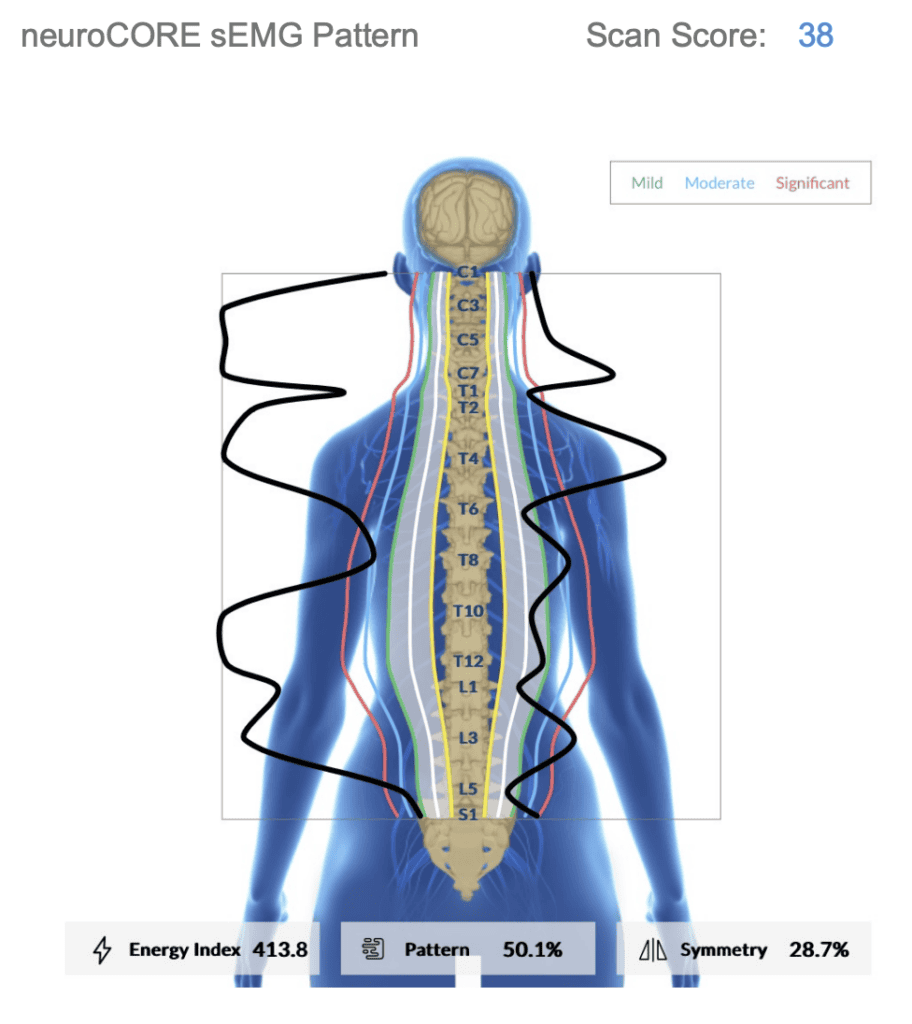
The biggest sign this is a Raging Bull scan is the very high Total Energy Score of 413.8—when the normal is around 100. This shows the child’s nervous system is stuck in full fight-or-flight mode, affecting motor development (like standing and walking), sleep, behavior, emotions, digestion, and more.
This child also shows signs of a Drunken Bull, with low scores in the other two areas, indicating poor coordination and imbalance.
Drunken Bull (Low Pattern + Symmetry) EMG Scan:

For this child, her Pattern score being low (24.2) signifies she’s struggling with ‘Drunken Bull’ type neurological challenges – emotional regulation, sensory processing, motor coordination, digestion, and more.
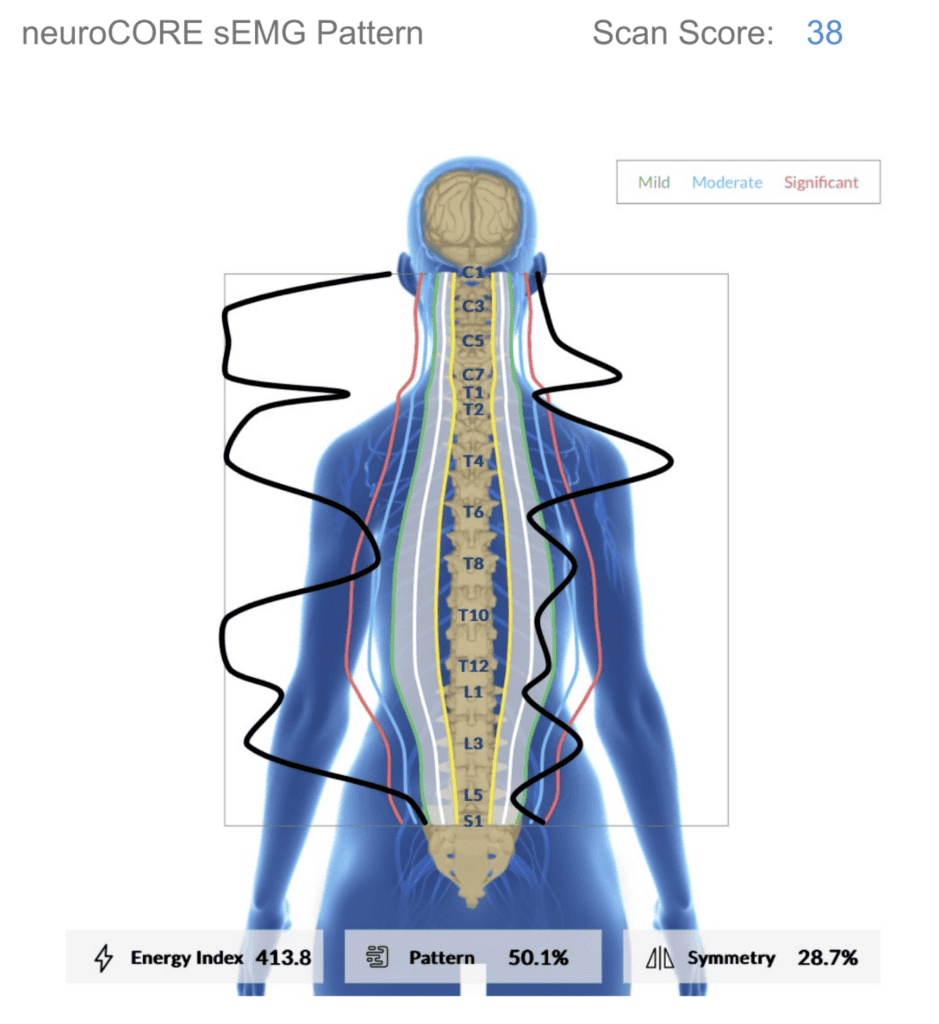
Heart Rate Variability (HRV) Scans: Measuring Resilience
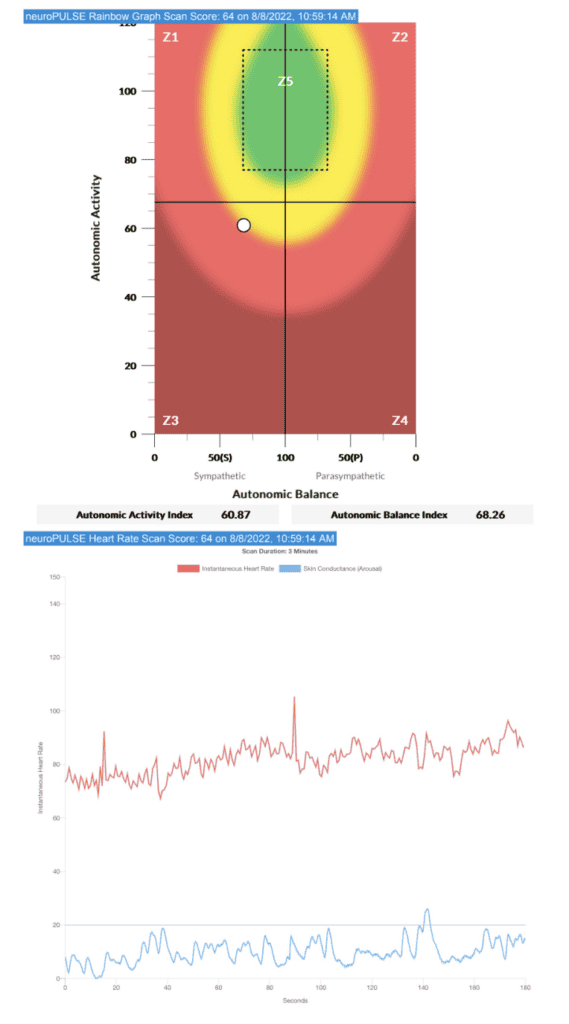
HRV scans give us a big-picture view of how healthy and balanced the autonomic nervous system is. The key word is “variability”—because strong neurological health means being able to adapt and bounce back from stress.
Whether it’s fighting off illness, handling emotional stress, or dealing with changes in routine, adaptability is the foundation of good health.
Many parents of sensory or spectrum kids say they wish their child was more flexible and less rigid. The HRV scan helps explain why that’s a struggle at first—and shows improvement over time with chiropractic care.
What We Often See on HRV Scans
Most scans in our office show:
- Shifted Left – the child is stuck in fight-or-flight mode or has poor vagal tone (parasympathetic exhaustion).
- Shifted Low – the child has low energy and poor adaptability (low reserve capacity).
The white dot on the HRV graph shows these patterns clearly and helps us track progress.
What the HRV Scan Reveals About Stress
In many HRV scans, like this one, we see rising heart rate (red line) and increased skin response (blue line) over the short 3-minute test. This shows how anxiety and stress build up quickly—even while sitting still. Now imagine that same stress buildup during school, bedtime, or daily routines. It’s no wonder so many kids struggle.
This kind of stress response—caused by subluxation and sympathetic dominance—is at the root of many daily challenges families face.
Wound Up & Worn Out: The New Normal
Most families today live in a constant state of “go”—feeling wired but tired. It’s like a toddler who skipped their nap: exhausted, emotional, and overwhelmed.
Just like infants with colic often grow into kids with sensory or spectrum challenges, children don’t “grow out of” stress-related issues—they grow into ADHD, anxiety, sleep struggles, and even depression if left unaddressed.
HRV Scans: A Game-Changer for Mental & Emotional Health
HRV scans help us identify the real cause of challenges with mood, energy, focus, and sleep—so we can help without medication. They also let us track progress as neurologically-focused chiropractic care helps restore calm, balance, and adaptability.
The chart below shows the life-changing improvements families experience, backed by clear changes in their HRV scans.

The Results Speak for Themselves
Millions of people rely on medications for sleep, mood, and pain relief—often with side effects. But with neurologically-focused chiropractic care, we see those same improvements (and more) in just minutes—naturally and safely, without drugs.
Putting It All Together
Dr Tim will walk you through each INSiGHT Scan, but the real power comes from seeing how they work together to give a full picture of your child’s nervous system and overall health.
These scans do exactly what the name promises—provide insight into your child’s most important system: the nervous system.
Think of it as the “mom” of the body—organizing, regulating, and supporting everything. But like many moms, it can get wound up and worn out. The good news? It doesn’t have to stay that way.
Dr Tim will create a personalized Care Plan designed just for your child. With each adjustment, you’ll start to see that stuck stress and tension fade—making room for calm, healing, and healthy development.

